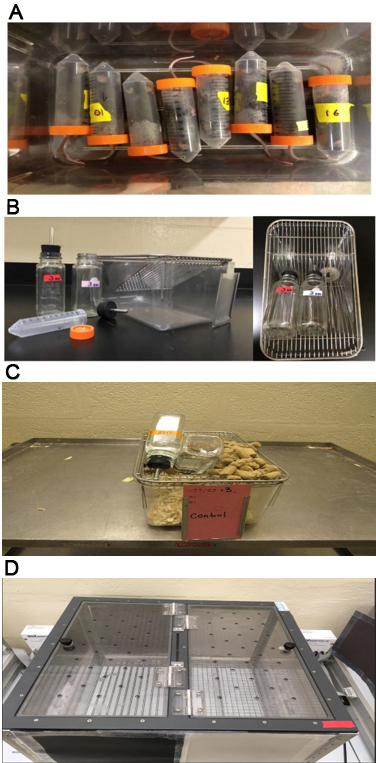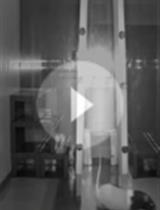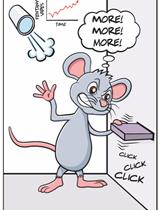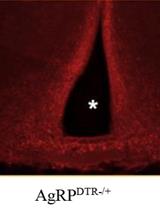- EN - English
- CN - 中文
Behavioral Evaluation of Seeking and Preference of Alcohol in Mice Subjected to Stress
承受应激小鼠的觅食和酒精偏好的行为学评估
发布: 2018年10月20日第8卷第20期 DOI: 10.21769/BioProtoc.3061 浏览次数: 6312
评审: Edgar Soria-GomezMohammed Mostafizur RahmanOscar Prospero
Abstract
The alcohol preference model is one of the most widely used animal models relevant to alcoholism. Stressors increase alcohol consumption. Here we present a protocol for a rapid and useful tool to test alcohol preference and stress-induced alcohol consumption in mice. In this model, animals are given two bottles, one with a diluted solution of ethanol in water, and the other with tap water. Consumption from each bottle is monitored over a 24-h period over several days to assess the animal’s relative preference for the ethanol solution over water. In the second phase, animals are stressed by restraining them for an hour daily and their subsequent preference of tap water or the ethanol solution is evaluated. Preference is measured by the volume and/or weight or liquid consumed daily, which is then converted to a preference ratio. The alcohol preference model was combined with the conditioned place preference paradigm to determine alcohol conditioning and preference following the deletion of CB2 cannabinoid receptors in dopaminergic neurons in the DAT-Cnr2 Cre-recombinant conditional knockout (cKO) mice in comparison with the wild-type control mice.
Keywords: Alcohol (酒精)Background
Many aspects of alcoholism and alcohol consumption can be studied through animal models. Alcohol induces positive reinforcement, and animals can seek alcohol and even work for it. However, alcohol can also be a negative reinforcement, since it is capable of reducing anxiety. No animal model is able to duplicate the complex features of alcoholism. Oral ethanol self-administration is widely used for examining specific aspects of behavior and physiology relevant for understanding alcoholism (Mardones and Segovia-Riquelme, 1983; Cunningham et al., 2000). Mice can be genetically manipulated at cell type specific levels and therefore are valuable for research into the cell type specific genetic determinants of alcoholism.
The alcohol preference model is one of the most widely used animal models relevant to alcoholism. This model meets important criterion, which is that the ethanol should be self-administered orally (Cicero, 1980; Crabbe et al., 2010). An animal’s genotype exerts a strong influence on self-administration in this model. Some mouse strains, like the inbred strain of mouse C57BL/6J (Rhodes et al., 2005), present a genetically influenced high preference for ethanol and they voluntarily consume it orally (Yoneyama et al., 2008; Barkley-Levenson and Crabbe, 2012). The conditioned place paradigm (CPP) is widely used to explore the effects of addictive substances including alcohol, taking advantage of learned associations. Therefore, alcohol CPP measures the association of alcohol with a particular environment to determine whether mice can acquire alcohol CPP.
Stress can interact with ongoing ethanol consumption to trigger increased intake (e.g., self-medicating behavior), thereby increasing initial susceptibility to alcohol use disorders. Among the stressors, a restraint model of acute and chronic stress can increase ethanol consumption (Yang et al., 2008).
New advances and accumulating evidence support a role for the endocannabinoid system in the effects of alcohol. The endocannabinoid system consists of two cannabinoid receptors, CB1Rs and CB2Rs, with endocannabinoids and the enzymes for the biosynthesis and inactivation of the endocannabinoids. Our goal here was to summarize the protocol used to measure alcohol preference in combination with stress-induced alcohol consumption. We also provide evidence that the endocannabinoid system plays a role in alcohol preference following dopaminergic neuron specific deletion of CB2Rs in the mouse model (Liu et al., 2017).
Materials and Reagents
- 50 ml Polypropylene Centrifuge Tubes with Attached Caps (Boekel Scientific, catalog number: 120021 )
- Bottles (see Figures 1B and 1C) with Sipper Caps (Chewy, catalog number: 101445 )
- Mice: Adult (7 weeks or older) mice (C57BL/6J) (THE JACKSON LABORATORY, catalog number: 000664 )
Note: Alternate strains and ages of mice may also be used. Mice are housed alone, each in their respective cages, in an environment with controlled temperature (around 23 °C) and humidity under a 12-12 h light-dark cycle with free access to food. See Animal considerations in Notes for more details. - 100% Alcohol and dilutions: 8%, 16% and 32% (Sigma-Aldrich, catalog number: 1012768 )

Figure 1. Photos showing experimental set-up for the evaluation of alcohol preference. A. Tubes in which naïve or conditional knockout mice and wild-type controls are subjected to acute stress. B. Tubes, water bottles, and a clean empty mouse cage. C. Image of the control cage. D. Image of the apparatus for conditioned place preference.
Equipment
- Mouse polycarbonate home cages (7.5 in W x 11 in L x 5 in H) with standard woodchip mouse bedding (Fisher Scientific, catalog number: 01-286-13A)
Manufacturer: Tecniplast, catalog number: 1290D00SU .
Note: Standard cage changes are allowed during the habituation period (see below). However, it is recommended to avoid cage changes during the period of data collection to prevent leakage. The cage can be cleaned between phases. One cage for each subject mouse. - Stainless steel wire cage lid modified to allow space for two bottles and the food (Fisher Scientific, catalog number: 01-286-13A)
Manufacturer: Tecniplast, catalog number: 1290D00SU . - Drill with small (1 mm) drill bit (for making three small holes in top of 50 ml Polypropylene Centrifuge Tubes, to allow the mouse to breathe, and a single larger hole in the cap to insert the tail)
- Thermo Scientific weighing scale (Thermo Fisher Scientific, catalog number: 20031 )
Software
- Activity Monitor software (Med Associates, St. Albans, VT) (for automated data collection)
- GraphPad PRISM 6.0 software (GraphPad Software. Inc., San Diego, CA, USA) (for data analysis)
Procedure
文章信息
版权信息
© 2018 The Authors; exclusive licensee Bio-protocol LLC.
如何引用
Canseco-Alba, A., Schanz, N., Ishiguro, H., Liu, Q. and Onaivi, E. S. (2018). Behavioral Evaluation of Seeking and Preference of Alcohol in Mice Subjected to Stress. Bio-protocol 8(20): e3061. DOI: 10.21769/BioProtoc.3061.
分类
神经科学 > 行为神经科学 > 实验动物模型 > 小鼠
神经科学 > 神经系统疾病 > 动物模型
分子生物学 > RNA > RNA 检测
您对这篇实验方法有问题吗?
在此处发布您的问题,我们将邀请本文作者来回答。同时,我们会将您的问题发布到Bio-protocol Exchange,以便寻求社区成员的帮助。
提问指南
+ 问题描述
写下详细的问题描述,包括所有有助于他人回答您问题的信息(例如实验过程、条件和相关图像等)。
Share
Bluesky
X
Copy link













